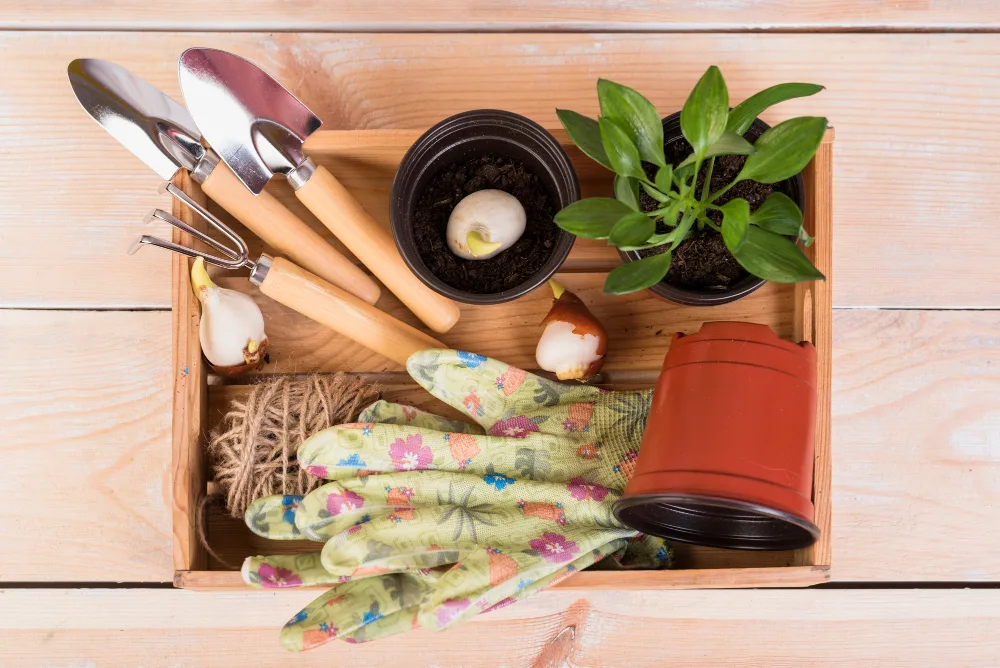Gardening success hinges on timing. Sow too early, and frost may bite tender seedlings; plant too late, and summer heat can scorch cool‑season crops. Mastering What to Plant Each Season turns a once‑a‑year pastime into a productive, four‑season lifestyle that supplies fresh produce, herbs, and flowers every month. This expanded guide maps out seasonal planting windows, monthly task lists, and sustainable practices drawn from The Year-Round Vegetable Garden for Beginners. Whether you garden on a balcony or a quarter‑acre plot, these strategies will help you keep beds full, soil fertile, and harvest baskets brimming.
1 Know Your Frost Dates and Microclimates
Before you pencil seed dates on a calendar, locate your average last spring frost and first autumn frost. In North America, the USDA Hardiness Zone Map or your national equivalent is a starting point, but backyards often hide microclimates—warmer south‑facing walls or cooler low spots. Track temperatures with a cheap max–min thermometer for a season; you’ll learn where tomatoes ripen first and where basil cries for warmth.
Tools & Tips
- Interactive Map: Plug your ZIP code into the USDA Plant Hardiness Map (external).
- Flag Frost Pockets: Cold air flows downhill; avoid planting tender crops in dips.
- Extend Margins: Use cold frames or row covers to shave 2–4 weeks off frost risk—methods detailed in Growing Under Cover.
2 Spring (March–May): Awakening the Garden
Early spring soils hover at 40–50 °F / 4–10 °C—just warm enough for hardy seeds. As daylight stretches past 10–12 hours, roots respond.
Early Spring Planting List
| Crop | Method | Key Notes |
|---|---|---|
| Peas (shelling, snap) | Direct‑seed | Soak 6 hours; inoculate with rhizobia for nitrogen boost. |
| Radishes | Direct‑seed | Sow every 10 days; harvest in 25 days. |
| Spinach | Direct‑seed | Cold‑tolerant varieties like ‘Bloomsdale’ resist bolting. |
| Asian greens (pak choi, tatsoi) | Direct or transplant | Grow under fleece to thwart flea beetles. |
| Kale & Collards | Transplant | Start indoors 6 weeks before planting out. |
| Onion sets/shallots | Transplant | Favor well‑drained, compost‑rich beds. |
Soil Prep
- Work 2 inches of compost into the top 6 inches. Avoid tilling deep; see No‑Dig Gardening.
- Rake beds into raised rows, which warm faster and improve drainage—learn how in Raised Row Gardening.
Late Spring Transition (Soil > 60 °F / 16 °C)
When lilacs bloom or soil probes read 60 °F, transplant warmth lovers:
- Tomatoes: Choose determinates like ‘Roma’ for short seasons; indeterminates (‘Sungold’, ‘Cherokee Purple’) for long ones.
- Basil & Dill: Direct‑seed basil once nights stay above 55 °F; sow dill away from carrots to reduce cross‑pest issues.
- Summer Squash & Zucchini: Direct‑seed or transplant; protect with squash‑bug‑proof mesh.
- Sweet Corn: Plant in square blocks of at least 3 × 3 rows for proper pollination.
April–May Task List
- Mulch Paths: Lay straw or wood chips to suppress spring weeds.
- Install Trellises: Put up pea netting and tomato cages now to avoid root disturbance later.
- Succession Sow: Every 2 weeks, sow lettuce, arugula, and radishes for continuous salads.
3 Summer (June–August): Heat, Succession, Preservation
Heat‑Seeking Staples
- Peppers: From sweet bells to super‑hots—see Peppers of the World for variety tips.
- Eggplant: Blossoms drop below 60 °F nights; grow in black mulch or large containers on sunny patios.
- Okra: Thrives in 90 °F heat; harvest pods under 4 inches to prevent toughness.
- Melons & Cucumbers: Train vertically to save space—learn trellising patterns in Small Plot, Big Harvest.
Mid‑Summer Succession and Interplanting
Even in scorching July, you can sow crops that mature before frost:
| Crop | Days to Harvest | Last Planting (days before frost) |
| Bush Beans | 50–55 | 60 |
| Baby Lettuce | 30 | 45 |
| Beet Greens | 35 | 50 |
| Fast Carrots (‘Adelaide’) | 55 | 70 |
Interplant Examples
- Carrots under Tomatoes: Carrots sprout in the shade of young tomato plants, then mature after lower leaves are pruned.
- Radishes with Cucumbers: Radishes grow and finish before sprawling vines need space.
Water & Soil Management
- Deep Soak: 1–1.5 inches per week, delivered via drip or soaker hose to minimize leaf disease.
- Mulch: Two inches of shredded leaves conserve moisture and feed microbes.
- Side‑Dress: At first fruit set, feed with fish emulsion or diluted compost tea—recipes in Composting 101.
July–August Tasks
- Prune Tomatoes: Remove lower foliage for airflow; top indeterminates 4 weeks before final frost to ripen existing fruit.
- Preserve the Plenty: Freeze shredded zucchini, can salsa, or dehydrate herbs.
- Plan Fall Garden: Start brassica seedlings indoors under lights 10 – 12 weeks before first frost.
4 Fall (September–November): Second Spring & Storage Crops
As day length dips below 12 hours, cool‑season crops regain vigor. Soil still radiates summer warmth—perfect for fast growth before frost.
Early Fall Planting Chart (Count Back from First Frost)
| Crop | Start Indoors | Direct‑Seed | Notes |
| Broccoli, Cauliflower | 10–12 wks | — | Transplant into shade, then full sun. |
| Cabbage (storage) | 8–10 wks | — | Choose dense‑headed ‘Storage No. 4’. |
| Carrots | — | 8–10 wks | Keep seedbed moist with burlap. |
| Spinach | — | 6 wks | ‘Giant Winter’ overwinters under low tunnel. |
Frost‑Sweetened Delights
Light frosts boost sugar in kale, Brussels sprouts, and parsnips. Taste improves, while cell walls strengthen for cold.
Extending the Harvest
- Row Covers & Low Tunnels: Fabric adds 4–6 °F; plastic tunnels add 10–15 °F.
- Cold Frames: Old windows on cedar boxes shelter lettuces into December.
- Overwinter Garlic: Plant in October, mulch 4 inches. Harvest scapes in June.
Soil Rejuvenation & Cover Crops
After final harvest, sow crimson clover or winter rye. They suppress winter weeds and add biomass. Learn details in What Is Green Manure?.
5 Winter (December–February): Indoor Greens, Planning, Maintenance
Indoor & Protected Crops
- Microgreens & Sprouts: Radish, sunflower, and pea shoots deliver greens in 7–14 days.
- Windowsill Herbs: Regrow basil, mint, or green onions from kitchen scraps—techniques in Growing Vegetables from Scraps.
- Cold‑Hardy Greens: Under unheated tunnels, grow mâche, claytonia, and winter spinach.
Winter Work List
- Tool Tune‑Up: Clean, sharpen, and oil pruners and shovels.
- Crop‑Rotation Blueprint: Use The Essential Guide to Crop Rotation to prevent disease cycles.
- Seed Inventory & Orders: Check germination rates; prioritize open‑pollinated varieties for seed saving.
- Plan Infrastructure: Build compost bins, rain barrels, or a low‑cost hoop house outlined in The Year-Round Vegetable Garden for Beginners.
Indoor Pest Vigilance
Fungus gnats love damp trays. Bottom‑water seedlings, apply sand mulch, and set yellow sticky cards to monitor populations.
6 Perennial Crops and Orchard Add‑Ons
While annuals rotate, perennials anchor plots.
- Asparagus & Rhubarb: Plant crowns in early spring; harvest lightly in year 2.
- Berry Brambles: Fall is prime for setting raspberries or blackberries—see Attracting Pollinators to Your Vegetable Garden for blossom‑boosting companions.
- Fruit Trees: Bare‑root apples and peaches go in while dormant (late winter/early spring). Mulch and stake securely.
Perennials knit soil, provide habitat, and deliver produce with minimal yearly input.
7 Troubleshooting Seasonal Challenges
| Season | Common Issue | Symptoms | Organic Remedy |
| Spring | Damping‑off | Seedlings collapse | Sterilize trays; good airflow |
| Summer | Blossom‑End Rot | Dark sunken spot | Maintain calcium, steady watering |
| Fall | Aphids on Brassicas | Leaf curling | Release ladybugs; spray neem |
| Winter | Powdery Mildew under cover | White film on leaves | Improve ventilation; sulfur powder |
Reference broader methods in Eco‑Friendly Pest Control for integrated strategies.
8 Creating Your Personalized Garden Calendar
Building a custom schedule turns theory into action:
- Back‑Calculate: Note frost dates, subtract crop days‑to‑maturity plus 14 days buffer.
- Layer Successions: Slot fresh sowings every 2 weeks for cut‑and‑come‑again crops.
- Set Reminders: Use printable templates or digital calendars—tutorial in How to Create a Garden Calendar.
- Review Monthly: Adjust plans for unexpected weather or pest outbreaks.
9 Bringing It All Together
A thriving garden is a living timeline—roots swelling under spring rains, vines stretching in summer sun, brassicas sweetening in autumn chill, and microgreens greening winter windowsills. By aligning planting dates with seasonal cues and local microclimates, you’ll ensure continuous harvests, reduce crop failures, and foster resilient soil.
Remember: observation beats rigid rules. Keep notes, celebrate successes, tweak mistakes, and lean on resources like The Year-Round Vegetable Garden for Beginners for deeper dives into four‑season crop rotations, bio‑intensive spacing, and homemade low‑tunnels. With a year‑round mindset, your patch of earth—or balcony box—can feed you fresh flavors in every month.


Leave a Reply